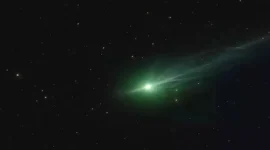July 16, 2025 — 12:00 UTC
In a major astronomical breakthrough, NASA’s James Webb Space Telescope (JWST) has uncovered an extraordinary black hole in a galaxy unlike any seen before. Located approximately 8 billion light-years from Earth, this newly identified galaxy has been dubbed the Infinity Galaxy due to its remarkable figure-eight shape, resembling the mathematical symbol for infinity. The unusual discovery centers around a supermassive black hole not found in the core of either of the two galaxies believed to have merged, but astonishingly in the space between them — a location that has left astronomers baffled and excited in equal measure.
The Infinity Galaxy is believed to be the product of a rare, head-on collision between two massive disk galaxies. This violent interaction created two red-glowing galactic nuclei and vast rings of star formation around each, producing a structure that is both scientifically intriguing and visually striking. JWST’s infrared imaging revealed this detailed structure, confirming the figure-eight configuration and showcasing the chaotic aftermath of the galactic merger. A distinct area between the two central bulges glowed brightly in hydrogen-alpha emission, indicating the presence of ionized gas — a key clue that led researchers to a deeper discovery.
Amid this swirling galactic debris, astronomers detected a powerful signal consistent with a supermassive black hole, estimated to be around 1 million times the mass of our Sun. Even more surprising was its position — not within either galaxy’s core, but in the bridge of gas connecting them. This positioning suggests that the black hole did not originate in either galaxy and later migrate, but rather formed in situ from a direct collapse of the dense gas in the bridge — a rare and previously unconfirmed formation scenario.
The detection of the black hole was made possible through a coordinated use of multiple observatories. The JWST provided deep-field imaging and spectroscopy, while the Chandra X-ray Observatory confirmed high-energy emissions consistent with accreting material. Simultaneously, the Very Large Array (VLA) detected associated radio signals, and spectroscopy from the Keck Observatory in Hawaii measured redshift and motion, confirming that the black hole shares the same velocity as the surrounding gas. This alignment supports the idea that the black hole formed directly from the gas cloud in which it currently resides — one of the strongest indicators yet for the “direct collapse” theory of black hole formation.
This finding challenges long-held assumptions about how supermassive black holes form and grow. Traditionally, astronomers believed black holes originated as “light seeds,” formed when massive stars collapse at the end of their life cycles. These small black holes then grow by merging with others or by feeding on surrounding material, a process that can take billions of years. However, this theory fails to explain how some massive black holes managed to appear so early in the universe’s history — as little as 500 million years after the Big Bang.
The newly discovered black hole in the Infinity Galaxy supports a competing hypothesis: the direct collapse model. According to this model, under certain extreme conditions, dense clouds of primordial gas could collapse directly into massive black holes, bypassing the stellar death phase entirely. This allows black holes to form much more quickly and grow rapidly, potentially explaining the presence of massive black holes in the early universe.
Lead researcher Pieter van Dokkum of Yale University explained the significance of the finding. “We think we’re witnessing the birth of a supermassive black hole. If confirmed, this will be the first time astronomers have ever directly seen such a process in action,” he said. The discovery provides compelling evidence that dense gas structures in merging galaxies can produce heavy-seed black holes directly — a major shift in our understanding of cosmic evolution.
Further supporting the direct collapse theory is the fact that the black hole’s velocity is tightly aligned with that of the surrounding gas, indicating that it was born in that very region. Additionally, there is no evidence of a hidden third galaxy or a runaway black hole ejected from another system, making alternate explanations unlikely. The ring structures and bright star-forming regions add more complexity to the scene, suggesting that the merger not only triggered intense star formation but also set the stage for black hole formation via gravitational collapse and gas compression.
The team behind the discovery utilized both archival Hubble data and new JWST observations to compare the galaxy’s current state with its earlier snapshots. Spectroscopic analysis revealed that the galaxy merger occurred approximately 50 million years ago — recent in cosmic terms. The black hole, now at ~1 million solar masses, appears to have formed within a few million years after the collision, suggesting rapid mass accumulation and further supporting the direct collapse hypothesis.
This remarkable black hole joins a growing list of unexpected discoveries by the JWST. Earlier this year, the telescope helped detect massive black holes in galaxies as early as redshift z = 10 — around 500 million years after the Big Bang — raising questions about how they could have grown so large in such a short time. The Infinity Galaxy black hole may finally provide the missing piece in the puzzle, offering a live example of how black holes of substantial mass can appear rapidly under the right conditions.
Upcoming research will involve more detailed spectroscopy using JWST’s NIRSpec instrument and adaptive optics imaging with the Keck Observatory to map the region’s structure at even finer resolution. Astronomers also plan to simulate the gas dynamics in the Infinity Galaxy to confirm if the observed conditions can indeed lead to a direct collapse, or if other processes may be contributing to black hole formation.
The implications of this finding are vast. If confirmed, the direct collapse mechanism may not only explain ancient black holes from the early universe but could also suggest that such processes are still occurring in certain extreme environments. This could reshape the way astronomers understand black hole growth, galaxy evolution, and the early phases of structure formation across cosmic history.
On a broader scale, this discovery adds to the growing realization that the universe is far more diverse and dynamic than previously believed. The Infinity Galaxy, with its dual ring structures, colliding cores, and a black hole born in a gas bridge, represents a cosmic laboratory unlike any other. It serves as a vivid reminder of the powerful and creative forces at play when galaxies collide — forces capable of building stars, forming new galaxies, and even forging the most mysterious objects in the universe: black holes.
As astronomers prepare for further observations and refined simulations, the Infinity Galaxy may soon become one of the most important case studies in astrophysics. Its unique features and enigmatic black hole offer a front-row seat to the birth of a cosmic giant, providing a rare glimpse into a process that shaped the very fabric of our universe billions of years ago — and may still be shaping it today.




